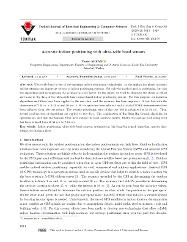Accurate indoor positioning with ultra-wide band sensors
Abstract
Ultra-wide band is one of the emerging indoor positioning technologies. In the application phase, accuracy and interference are important criteria of indoor positioning systems. Not only the method used in positioning, but also the algorithms used in improving the accuracy is a key factor. In this paper, we tried to eliminate the effects of off-set and noise in the data of the ultra-wide band sensor-based indoor positioning system. For this purpose, optimization algorithms and filters have been applied to the raw data, and the accuracy has been improved. A test bed with the dimensions of 7.35 m x 5.41 m and 50 cm x 50 cm grids has been selected, and a total of 27,000 measurements have been collected from 180 test points. The average positioning error of this test bed is calculated as 16.34 cm. Then, several combinations of algorithms are applied to raw data. The combination of Big Bang-Big Crunch algorithm for optimization, and then the Kalman Filter have yielded the most accurate results. Briefly, the average positioning error has been reduced from 16.34 cm to 7.43 cm.
Source
Turkish Journal of Electrical Engineering & Computer SciencesVolume
28Issue
2URI
https://hdl.handle.net/20.500.12469/2890https://doi.org/10.3906/elk-1911-79
https://search.trdizin.gov.tr/yayin/detay/335117
















